European Space Agency, Astrium, Eurockot, COM DEV International—Swarm To Space
Eurockot Launch Services GmbH successfully launched the three satellite Swarm constellation for the European Space Agency on November 22nd at 12:02 hrs UTC (13:02 hrs CET), via a Rockot launcher from Plesetsk Cosmodrome in Northern Russia.

The Eurockot launch of the SWARM constellation via a Rockot launch vehicle. Photo courtesy of Eurockot.
Rockot orbited the Swarm Earth Explorer mission into an orbit of 87.6 degrees at 490 km altitude. This launch was Eurockot’s third successful launch for the European Space Agency.
Swarm is a constellation of three satellites which will explore the Earth`s magnetic field and its change with unique accuracy. As part of ESA’s Living Planet Program, Swarm will provide a unique inside view of the Earth and will broaden our understanding of atmospheric processes and ocean circulation which effect climate and weather.
Each Swarm satellite has a mass of 500kg and, after their simultaneous release from the Rockot launcher, will move into different polar orbits using their own propulsion systems. All three Swarm satellites were built by Astrium GmbH at Friedrichshafen
Eurockot’s launch vehicle Rockot launched the Swarm constellation from its dedicated launch pad LC133 at Plesetsk Cosmodrome in Northern Russia, about 800km from Moscow.
Eurockot’s next missions in late 2014 and early 2015 will be the launches of the Sentinel-2A and Sentinel-3A satellites.
Both spacecraft are part of the range of satellites belonging to the Copernicus program financed by the European Union. Eurockot was contracted to perform the launches by the European Space Agency in February 2012.
Eurockot Launch Services GmbH is the joint venture of EADS Astrium (51 percent) and Khrunichev Space Center (49 percent) and performs launch services for operators of Low Earth Orbit (LEO) satellites using the flight-proven Rockot launch vehicle.
The Swarm satellite mission—developed and built by Astrium—saw the satellites placed on their orbits approximately 92 minutes after launching.
Over a period of at least four years, the European Space Agency’s (ESA) Swarm mission will measure the Earth’s magnetic field and its development with previously unattained accuracy.
The findings will improve our understanding of the Earth’s interior and how it interacts with space. An improved understanding of the magnetic field also has significant practical uses.
In particular, it is anticipated that this research will ultimately contribute to more precise navigation with compasses or gyros, which can improve, for example, directional drilling in resource exploitation. In addition, it is expected to help improve space weather models.
Astrium is the prime contractor for ESA’s Swarm satellite trio. Eurockot Launch Services, an Astrium subsidiary, is responsible for the launch.
For more information regarding Swarm, access
http://www.esa.int/Our_Activities/Observing_the_Earth/The_Living_Planet_Programme/Earth_Explorers/Swarm
For further information regarding Astrium, select http://www.astrium.eads.net/
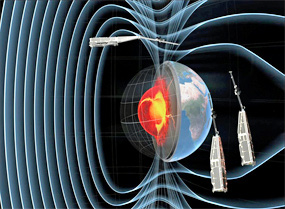
Another artistic rendition of the SWARM constellation. Image courtesy of ESA.
Additional Eurockot info: http://www.eurockot.com/
COM DEV International Ltd. is also heavily involved in the Swarm mission. The company has three state-of-the-art scientific instruments aboard the Swarm mission.
The data collected by the Swarm satellites will provide new insights into a range of phenomena about the magnetic field which surrounds the Earth and shields it from the harmful effects of solar storms, cosmic rays and charged particles that bombard the planet. Strong solar storms have caused power and communication blackouts, and damaged satellites on orbit. Without Earth’s protective magnetic shield, the development of life would likely have been impossible. Evidence points to a weakening of the planet’s magnetic shield and the Swarm mission will enable scientists to understand the causes.
COM DEV designed, developed, integrated and tested the Canadian Electrical Field Instrument (EFI), which is integrated into the instrument suites of all three satellites. Each Canadian EFI will collect information about the interaction of Earth’s magnetic fieldwith the solar wind and electric currents, and their effects on Earth.
Each Canadian EFI consists of two types of sensors and an electronics assembly. The two sensor types are the Thermal Ion Imagers and Langmuir Probes. The Thermal Ion Imagers, developed by the University of Calgary, will provide a high resolution 3D picture of the ion flow around the Earth. The Langmuir Probes, developed by the Swedish Institute of Space Physics, measure electron density, electron temperature and the electric potential of the satellite.
Under the Canada-ESA Cooperation Agreement, Canada is a participating state of ESA’s Earth Observation Envelope Program (EOEP). This allows Canadian organizations to take part in the development and operation of EOEP missions by bidding on and obtaining related contracts, and enabling Canadian groups to access the data collected by these missions. ESA awarded the prime contract for the Canadian EFI to COM DEV in 2007.
The total value of the contract was $16.6 million and the work was completed at the Company’s facilities in Cambridge, Ontario. The CSA is funding work by Canadian universities to validate and perform scientific research with data from the Swarm mission and with data from Canadian ground- and space-based instruments. COM DEV’s earlier work on the Cold Plasma Analyzer (CPA) instrument for Sweden’s Freja satellite, and the Thermal Plasma Analyzer (TPA) instrument provided on Japan’s Nozomi satellite, contributed to the success of the Canadian EFI project. Both the CPA and TPA projects were funded by the CSA.
“I appreciate the confidence that ESA expressed in COM DEV by selecting the company to be the prime contractor for three instruments that will make an important contribution toward the scientific goals of the Swarm mission,” said Mike Pley, CEO of COM DEV International. “The CEFI project is a continuation of COM DEV’s world-leading heritage in space science, space weather, and space situational awareness instruments.”
The Swarm mission has a design life of four years. The satellites will travel in a polar low Earth orbit, two satellites side-by-side at an eventual altitude of 300 kilometers above the Earth, with the third maintaining an altitude of 530 kilometers. Data collected will be downloaded daily to the ESA’s ground station at Kiruna, Sweden and processed at the Center for Earth Observation at Frascati, Italy.
For further information regarding COM DEV International, select this direct link: http://www.comdev.ca/
The UK Space Agency adds that the satellites carry a new generation of magnetometers that will identify and measure the magnetic signals that stem from the various sources with unprecedented accuracy. These advanced sensors are mounted on the satellite’s 4m-long arm to minimize interference from the electric units on the craft.
Participants from the UK attended ESA’s Second International Science Meeting on the Swarm mission back in June of 2009 in Potsdam, Germany. The purpose of meeting was to bring together scientists and students, working in all fields of geomagnetism and/or the near-Earth electromagnetic environment, who would benefit from the Swarm constellation.
Swarm is comprised of a constellation of three satellites; two of which will orbit the Earth, side-by-side, with the third satellite in another orbital plane at the higher altitude. The three satellites are identical in size and shape, each measuring about 9.25 meters in length and all carry the same instrument package. A deployable arm makes up more than half of the length of the satellite and about half way along carries one of the main instruments—the so-called Vector Field Magnetometer. Apart from the long arm, which is deployed once in orbit, the satellite has no other moving parts. The solar panels are rigidly fixed to the satellite body forming a ‘roof’.
High-precision and high-resolution measurements of the strength, direction and variations of the Earth’s magnetic field, will provide valuable data, which is essential for modelling the geomagnetic field. The results will offer new insights into the Earth system by improving the understanding of the dynamics of the Earth’s core, the composition of the mantle and structure of the crust. Swarm will also enable analysis of the Sun’s influence on the Earth.
There’s additional information at:
http://www.bis.gov.uk/ukspaceagency/missions/Swarm#sthash.gDNQiXQk.dpuf
ESA’s three-satellite Swarm constellation was lofted into a near-polar orbit by a Russian Rockot launcher where, for a period of four years, it will monitor Earth’s magnetic field, from the depth of our planet’s core to the heights of its upper atmosphere.
The Swarm satellites will provide unprecedented insights into the complex workings of the magnetic shield that protects Earth’s biosphere from charged particles and cosmic radiation. They will perform precise measurements to evaluate its current weakening and understand how it contributes to global change.
The Rockot launcher lifted off from the Plesetsk spaceport in northern Russia at 12:02 GMT (13:02 CET) on November 22nd. Some 91 minutes later, its Breeze-KM upper stage released the three satellites into a near-polar circular orbit at an altitude of 490km. Contact was established with the trio minutes later through the Kiruna station in Sweden and the Svalbard station in Norway.
The three identical satellites were launched together on one rocket. Two satellites will orbit almost side-by-side at the same altitude—initially at about 460km, descending to around 300km over the lifetime of the mission.
The third satellite is in a higher orbit of 530km and at a slightly different inclination. The satellites’ orbits drift, resulting in the upper satellite crossing the path of the lower two at an angle of 90 degrees in the third year of operations. The different orbits, along with the satellites’ various instruments, optimize the sampling in space and time, distinguishing between the effects of different sources and strengths of magnetism.
The field protects our planet from cosmic radiation and charged particles that bombard Earth in ‘solar winds’. Without this protective shield, the atmosphere, as we know it, would not exist, rendering life on Earth virtually impossible. By analyzing the different characteristics of the field, the mission will provide new insight into many natural processes, from those occurring deep inside the planet to weather in space caused by solar activity. In turn, this information will yield a better understanding of why the magnetic field is weakening.
All three satellites are controlled by ESA teams at the European Space Operation Centre in Darmstadt, Germany. Over the next three months of commissioning, their scientific payloads will be verified and they will move to their respective operational orbits.
“Swarm is about to fill a gap in our view of the Earth system and in our monitoring of global change issues,” said Volker Liebig, ESA’s director for Earth Observation. “It will help us to better understand the field that protects us from the particles and radiation coming from the Sun.”
Swarm is ESA’s fourth Earth Explorer mission, coming after the successful CryoSat, GOCE and SMOS satellites. These are all missions that expand the knowledge of Earth and its environment.
The combination of data collected by Swarm will deliver precious information on the sources of the magnetic field inside Earth. This includes understanding how the magnetic field is related to the motion of molten iron in the outer core, how the conductivity of the mantle is related to its composition and how the crust has been magnetized over geological timescales.
They will also investigate how the magnetic field relates to Earth’s environment through the radiation belts and their near-Earth effects, including the solar wind energy input into the upper atmosphere.
Swarm will also be able to distinguish between the various sources of the planet’s magnetic field and ensure continuity in its monitoring from space in conjunction with measurements from ground observatories
Earth’s magnetic field plays a major role in protecting the biosphere because it generates a bubble around the planet that deflects charged particles and traps them in the radiation belts. This shielding protects all life on Earth from the bombardment of heavy ions coming from the Sun and deep space.
Since the 1980s, previous missions have showed this field to be weakening, which could be a sign that the north and south magnetic poles are beginning to reverse—known to have occurred on multiple occasions during geological times.
Although such inversions usually take thousands of years to complete, a further weakening of magnetic protection could lead to an increase in events that damage the orbiting satellites or disrupt power grids and other electrical systems on the ground.
For more information regarding the ESA’s Swarm role:
* * * * * * * * *
ULA, NASA, Tencate—Sending MAVEN To The Stars + Mars
United Launch Alliance has chalked up another successful launch for NASA. The November 18th event presented a perfect Atlas V launch at Space Launch Complex 41 at Cape Canaveral Air Force Station in Florida as MAVEN was sent on her journey to the Red Planet.
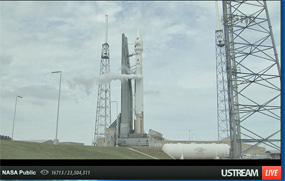
MAVEN sits atop a ULA Atlas V awaiting its launch at Cape Canaveral AFS. Image capture from USTREAM’s launch coverage.
This was ULA’s 10th launch of the year and marks the 41st Atlas V mission and the 76th launch for ULA.
This mission was launched aboard an Atlas V 401 configuration vehicle, which includes a four-meter diameter payload fairing. The Atlas booster for this mission will be powered by the RD AMROSS RD-180 engine and the Centaur upper stage will be powered by a single Aerojet Rocketdyne RL10A engine.
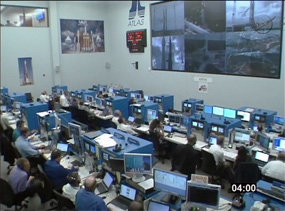
Launch control center all prepared to “Go...” — Image captured from the USTREAM Live streaming widecast of the MAVEN launch.
MAVEN will examine specific processes on Mars that led to the loss of much of its atmosphere. Data and analysis will help planetary scientists understand the history of climate change on the red planet and provide further information on the history of planetary habitability.
The MAVEN spacecraft will be the first probe to directly assess the mysteries of the atmosphere of Mars. Previous missions clearly show the past presence of water, but how it and the other gas components were lost is uncertain.
Some may have been stripped away by the Sun, while others may still be on Mars, absorbed into its crust.
MAVEN will determine the present state of the upper atmosphere and today’s rates of loss to space, which will enable determination of the net integrated loss to space through time.
Weighing more than 5,600 lbs at launch, the spacecraft will generate 1,135 watts of power when it arrives in orbit via its solar panels. The solar panels have been designed in a ‘gull wing’ configuration to help stabilize the spacecraft as it dives through the Martian atmosphere as well as to carry magnetic field instruments at each tip.
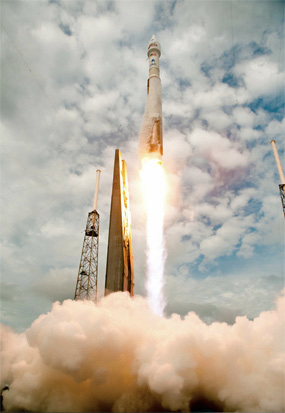
A United Launch Alliance (ULA) Atlas V rocket carrying NASA’s Mars Atmosphere and Volatile EvolutioN (MAVEN) spacecraft lifts off from Space Launch Complex-41 at 1:28 p.m. EST at Cape Canaveral AFS. Photo by Pat Corkery, United Launch Alliance
The fixed main antenna will return global data from the primary atmospheric mission as well as serve as a data relay for future missions.
Manufactured by Lockheed Martin Space Systems for NASA’s Goddard Spaceflight Center (GSFC), the spacecraft carries instruments provided by GSFC, the Colorado University Laboratory for Atmospheric and Space Physics, and the Space Sciences Laboratory at UC Berkeley.
The spacecraft includes an Articulated Payload Platform (APP), which is a deployable boom with a wide range of attitude capability. The APP will precisely point three instrument packages on its tip to sample the Mars atmosphere.
This suite of instruments includes the Neutral Gas and Ion Mass Spectrometer, the Imaging Ultraviolet Spectrometer, and the Suprathermal and Thermal Ion Composition instruments.
A separate deployed boom provides standoff from the spacecraft for the Solar Wind Electron Analyzer. Instruments mounted on the spacecraft body provide detailed measurements of the Sun’s electrons, ions, particles, and radiation. Two additional booms measure electron temperature and density.
Together, these instruments will provide unprecedented insight into Mars as it exists today, and how the planet was in the past.
The MAVEN mission was flown on an easterly trajectory from Space Launch Complex 41 at Cape Canaveral Air Force Station (CCAFS), Florida.
The mission started with the ignition of the RD-180 engine approximately 3.8 seconds before liftoff. Shortly after the ignition, the vehicle cleared the pad, performing its pitch/yaw/roll maneuvers.
Following maximum dynamic pressure, the RD-180 was throttled down to 95 percent. Guidance steering was enabled approximately 140 seconds into flight. Booster engine cutoff (BECO) occured 242.4 seconds into flight, followed by Centaur separation six seconds later.
Approximately four minutes into flight, the Centaur stage ignited its main engine (MES1). Eight seconds into the burn, the payload fairing is jettisoned.
Over the Atlantic Ocean, the burn lasted 9.5 minutes and used a special steering profile. This profile optimized the trajectory for the interplanetary target, placing the vehicle into a unique parking orbit tailored for the day and time of launch.
Following a 24-minute coast, the Centaur main engine is ignited for a second burn (MES2), lasting 5.5 minutes. Following Centaur engine shutdown (MECO2), the vehicle turned to the separation attitude and delayed separation for approximately three minutes to ensure that the down range Deep Space Network stations had contact with MAVEN during the separation event. Separation occurred over Australia at approximately 53 minutes after launch.
“United Launch Alliance is proud to be a part of this tremendous mission, working closely with the NASA Launch Services Program and MAVEN teams,” said Jim Sponnick, ULA vice president, Atlas and Delta Programs. “Missions to Mars are very exciting and over the last decade, ULA launch systems have been entrusted to launch all of NASA’s missions to the red planet, including the Spirit and Opportunity rovers and most recently the Mars Science Lab mission with the Curiosity rover.”
“In just a few days, the Centaur upper stage will celebrate its 50th anniversary since its first successful launch,” said Jim Sponnick, “Centaur has a rich heritage dating back to the beginning of human spaceflight and continues to reliably deliver critical science missions for NASA.”
ULA’s next launch is the Atlas V NROL-39 mission for the National Reconnaissance Office scheduled for December 5 from Space Launch Complex-3 at Vandenberg Air Force Base, California.
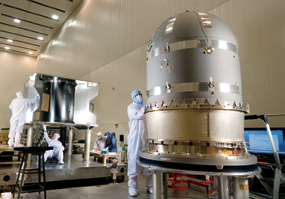
This photo shows the large hydrazine propellant tank prior to integration with the core structure of the MAVEN spacecraft at a Lockheed Martin clean room near Denver. The tank will hold 450 gallons of hydrazine propellant and is 6 feet 2 inches tall. The tank was built by ATK Aerospace Group, Commerce, California. The primary structure in the background is cube shaped at 7.5 feet x 7.5 feet x 6.5 feet high. Built out of composite panels comprised of aluminum honeycomb sandwiched between graphite composite face sheets, the entire structure only weighs 275 pounds. Photo is courtesy of Lockheed Martin.
ULA program management, engineering, test, and mission support functions are headquartered in Denver, Colorado. Manufacturing, assembly and integration operations are located at Decatur, Alabama, and Harlingen, Texas. Launch operations are located at Cape Canaveral AFS, Florida, and Vandenberg AFB, California.
TenCate advanced composites were launched, once again, for Mars on the MAVEN orbiter.
TenCate Advanced Composites, as a key supplier of advanced composite materials to Lockheed Martin, supports NASA on the Mars Atmosphere and Volatile Evolution (MAVEN) orbiter that was successfully launched earlier this week. The MAVEN orbiter will analyze the upper atmosphere of Mars, which will help scientists examine how the climate of Mars has changed over time due to the loss of atmospheric gases.
The core structure of the MAVEN spacecraft under construction at Lockheed Martin in Denver, Colorado.
TenCate has supported NASA and Lockheed Martin on prior Mars missions, including the Rover and Curiosity exploration vehicles. For the MAVEN orbiter, TenCate Advanced Composites provided a highly stable, engineered carbon fiber-reinforced composite material that was used to fabricate the primary bus structure of the orbiter.
This primary structure is cube shaped and was built by Lockheed Martin in Denver, Colorado, with high modulus composite face sheets sandwiched between aluminum honeycomb sheets. The entire primary structure is only 275 pounds, yet can withstand the launch forces of 6 g’s, which imparts loads of up to 61,000 lbs on the launch vehicle’s interface.
To learn more about TenCate Advanced Composites, access http://www.tencate.com/emea/aerospace-composites/default.aspx


